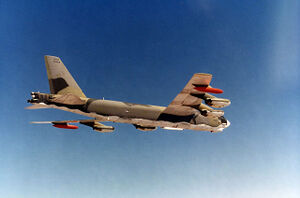1968 Thule Air Base B-52 crash (nonfiction)
On 21 January 1968, an aircraft accident (sometimes known as the Thule affair or Thule accident; Danish: Thuleulykken) involving a United States Air Force (USAF) B-52 bomber occurred near Thule Air Base in the Danish territory of Greenland.
The aircraft was carrying four hydrogen bombs on a Cold War "Chrome Dome" alert mission over Baffin Bay when a cabin fire forced the crew to abandon the aircraft before they could carry out an emergency landing at Thule Air Base. Six crew members ejected safely, but one who did not have an ejection seat was killed while trying to bail out.
The bomber crashed onto sea ice in North Star Bay, Greenland, causing the conventional explosives aboard to detonate and the nuclear payload to rupture and disperse, which resulted in radioactive contamination.
The United States and Denmark launched an intensive clean-up and recovery operation, but the secondary stage of one of the nuclear weapons could not be accounted for after the operation completed. USAF Strategic Air Command "Chrome Dome" operations were discontinued immediately after the accident, which highlighted the safety and political risks of the missions. Safety procedures were reviewed and more stable explosives were developed for use in nuclear weapons.
In 1995, a political scandal resulted in Denmark after a report revealed the government had given tacit permission for nuclear weapons to be located in Greenland, in contravention of Denmark's 1957 nuclear-free zone policy. Workers involved in the clean-up program have been campaigning for compensation for radiation-related illnesses they experienced in the years after the accident.
In the News
Fiction cross-reference
Nonfiction cross-reference
External links
- 1968 Thule Air Base B-52 crash @ Wikipedia

